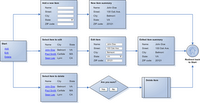Navigation pattern: minimal add-edit-delete
Design patterns are popular in software engineering. They provide time-tested, repeatable solutions to common problems. Since most programming problems can be distilled into a number of core tasks, design patterns work like templates; they solve each core task and allow you to derive a solution to the overall problem. Design patterns are abstract enough so that choosing the language and tools with which to apply them is up to you.
In my information architecture work I often come across navigation problems that have generally applicable solutions. Here's an example of a "navigation pattern" that you will hopefully find useful.
Design problem
A user needs to add, edit and delete items.
Pattern name
Minimal add-edit-delete

Click thumbnail to view image
When to use
In my information architecture work I often come across navigation problems that have generally applicable solutions. Here's an example of a "navigation pattern" that you will hopefully find useful.
Design problem
A user needs to add, edit and delete items.
Pattern name
Minimal add-edit-delete

Click thumbnail to view image
When to use
- In an application that is task and workflow oriented.
- When the user is expected to perform one task at a time to complete an action.
- Suitable for devices that are not feature-rich, such as mobile phones.
- Self-contained, has a minimal number of screens.
- Indicates page transitions clearly.
- Provides confirmation for an accomplished task.
- Navigable with links.

